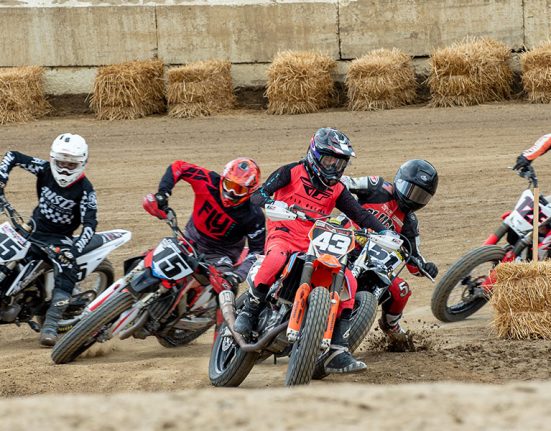Despite dire predictions from social media know-it-alls, expert evaluators are finding Milwaukee’s new adventure tourer seriously competent — and seriously fun!
May 7, 2021
By AMA Staff
Photography courtesy of Harley-Davidson
Editor’s Note: We don’t do much new-motorcycle coverage here at American Motorcyclist, as we realize most new bikes already get tons of coverage from a wide range of media outlets, some of which actually know what they’re talking about.
Still, some freshly minted motorcycles carry more weight than others in terms of impact and significance, and therefore deserve a closer look. And Harley-Davidson’s all-new Pan America 1250 adventure tourer is very definitely one of those.
It’s no stretch to say the Pan America is the most important Harley-Davidson in decades. Aside from incorporating a new and thoroughly modern powertrain that’ll be shared with a handful of new motorcycles in the coming years, the Pan America signals a dramatic broadening of Milwaukee’s product offerings away from cruisers.
Adventure tourers are not a new segment, of course, with BMW, KTM and others having established themselves strongly there during the last few decades…so Harley-Davidson is getting in late. Like the cruiser segment, the adventure class appeals to a boomer-heavy audience, and has for many years, so Harley-Davidson’s timing is certainly not ideal given demographic trends.
The function-first/semi-off-road dynamic of the adventure category is also pretty far removed from Harley-Davidsons’s custom-and-chrome wheelhouse, which probably explains all the hooting and hollering from the social media contingent a couple years ago when Harley-Davidson leaked images of the prototype Pan America.
All of which, as it turned out (and as so often happens), were totally wrong. Because if the reviews of the Pan America 1250 coming from the California desert (where the worldwide press launch happened over the last few weeks) tells us anything, it’s that Milwaukee designers and engineers did a bang-up job making the Pan America insanely functional, if not overly sexy. (Although, we must admit there’s something aesthetically welcoming in the Pan America, which ditches the typical narwhal-like tusk of a front fender for something more intimidating – like a blunt, charging ram.
In some ways, the old refrain about the definition of insanity being “when you do the same thing over and over and expect different results” is apropos here. Harley-Davidson, aside from the brilliant cruisers it hammers out year after year (and the all-new Electra Glide Revival model it just introduced is perhaps The Coolest Harley-Davidson Ever in our minds), needs new blood and new energy and a bit of a new direction, and not just do what it’s always done — and done well. The company is breaking the mold and breaking out of its cruiser-only shell, and the Pan America 1250 is the first hammer-slam in that effort.
So, here’s a sampling of Pan Analysis from the media landscape. Bike reviews are never one-size-fits-all, of course, so getting a picture from multiple outlets and evaluators who’ve actually ridden the bike makes a lot of sense from a reader- and member-service point of view. Enjoy!

The All-New Revolution Max 1250 Engine
Cycle World senior editor Justin Dawes summed up the all-new Revolution Max 1250 engine with an empathic “Wow!” as he described the feeling when he first grabbed a handful of throttle, as the engine has accomplished something Harley-Davidson is not known for: A high rpm-loving engine that kicks in strong at “2,200 rpm and continues to build with more and more velocity as you cross the 8,500-rpm mark.”
“After that it begins to taper off in aggression until you reach the rev limiter at 9,500 rpm. That’s 9,500 rpm from a Harley. And while the low-end and top-end performance are impressive, it’s the middle of the digital tach that is the sweetest. Third gear is a set-and-forget mark for winding backroads, as the Max pulls with simple tenacity at the 5K mark to spring you out of the corners. The lean-sensitive traction control, C-TCS in Harley-speak, is the least restrictive in this mode and will let the standard, specially developed Michelin Scorcher Adventure tires do much of the work. The future of this engine is very bright indeed,” he wrote.
More details on the engine from Dawes includes how the liquid-cooled 60-degree 1,252cc V-twin is not only the centerpiece the Pan America 1250, but also serves as a structural chassis member that allows for reduced weight.
Dawes went on to explain that while Harley-Davidson claims the engine can be run safely in regions with “low quality” gasoline, the 13.0:1 compression ratio requires 91-octane fuel for best performance. Anything less will cause knock sensors to trigger less aggressive ignition timing and fueling ratios, which will reduce power.

But after testing the bike and combing over details of the engine, Dawes found what he described as one of few misses in Harley’s design.
“The Revolution Max is a unitized powertrain, meaning the transmission is integrated in the same case as the engine, unlike H-D traditional Big Twins. The cable-actuated clutch is a slipper/assist unit. And here we discover the first of a few misses on the Pan America: There’s no quickshifter. Clutchless upshifting and downshifting has become a common feature in big-bore adventure motorcycles and Harley’s omission is a big oversight, especially because the Revolution Max 1250 is so rev-happy. Clicking through the gears is solid, with quick and effortless engagement, and the clutch pull is light thanks to the assist design. But I still want the snappiness and convenience of a quickshifter,” he wrote.
Still, his overall conclusion of the bike was widely positive.
“Harley-Davidson has entered the adventure-touring market with a real competitor for the icons of the segment. It’s powerful, it’s capable, and it’s innovative, all without losing Harley-Davidson identity. As much as the internet wanted a train wreck, H-D has delivered a locomotive,” he wrote.
Suspension

For the rundown on the suspension and multiple ride modes the Pan America 1250 offers for different riding environments, we turn to Cycle News’ Jesse Ziegler.
“First, when it comes to vehicle dynamics,” he wrote, “Harley-Davidson’s Vehicle Loading Control and Adaptive Ride Height (ARH) steal the show.”
“First, Vehicle Loading Control auto-adjusts suspension preload based on laden weight. Rider, rider plus passenger, rider after dinner, rider after dinner plus cases of beer for the campground — whatever load is applied to the motorcycle, the system automatically sets 30 percent sag by adjusting preload and will set itself accordingly. You don’t have to set anything, and the bike adjusts by itself. Awesome, right?”
According to Ziegler, those same set of auto-adjust sensors is what activates the Adaptive Ride Height (ARH) function, an industry-first technology introduced by Harley.
“[The ARH] simply lowers the motorcycle to the least amount of spring preload setting possible, dropping seat height by one to two inches (depending on ride height/laden weight) as the vehicle stops. Hear that? That’s the mic dropping on seat-height complaints,” he wrote. That is some extreme versatility in make the Pan America accessible to all types of riders and good on them for that one.
“ARH is tunable so you can keep it locked out at the preload at stops (tall people, or ultra-slow-speed riding) or delay the drop in long or short duration after a stop. I highly recommend dropping the bike when stopped, and I used the long-duration option so I could maneuver around tight, slow terrain without the bike lowering,” Ziegler added.
While Ziegler is not someone who struggles with seat height problems, he added that he still had the ARH feature turned all the time.
“Every time I stopped for another photo pass or to eat a snack, the bike settled down into a flat-foot, knee-bent seat height — extremely comfortable for me and hugely confidence inspiring for shorter riders. As soon as the vehicle starts rolling again, the system auto-adjusts ride height to the laden weight and you’re back to ripping like normal,” he wrote, adding that for more comfort with the diversity of body sizes, Harley has a variety of seats that raise and lower the height as much as four inches.

“On top of this…are five zones pre-programmed into the bike: Comfort, Balanced, Sport, Off-Road Soft and Off-Road Firm damping profiles. These are preloaded into Ride Modes, as well. So the suspension is both active and adjustable if you want to mix settings around as you create custom ride modes,” he wrote.
While he said the good press around the ARH and Semi-Active Suspension is well-deserved and he predicts the industry will copy the tech in short order, a “lowering bike alone will not make a great Adventure weapon” with off-road handling the ultimate test.
“Over-taxing a fork and shock at speed off-road is easy and making one cover the range of impacts out there is a challenge, but the Pan America’s Showa 47mm Balance Free Fork (BFF) with semi-active damping absolutely delivered. I went as fast and hard as I ever want to on this bike and it responded with control and balance almost every time. I slowly increased my pace to the point I was getting close to being irresponsible. And only once did I surprise the system at low speed hitting a very abrupt rock edge. It was an intentional test to see if the system would resist bottoming and it didn’t. The fork is really good across the board and shined in heavy braking or even the occasional all-wheel lift scenario (that’s a jump),” he explained.
Ride Modes

For the various ride modes on the Pan America we turn to a brief rundown by Rider’s Editor Greg Drevenstedt, who wrote a Top 10 review of the bike as they work on what will surely be an exhaustive technical review of the motorcycle to be published soon.
“Like nearly every high-spec adventure bike, the Pan America 1250 Special is outfitted with a full suite of electronic rider aids. It offers multiple ride modes — Sport, Road, Rain, Off-Road, Off-Road Plus, Custom Off-Road Plus, Custom A and Custom B — which automatically adjust the engine map (power output), throttle response, engine braking, traction control, ABS and suspension. Everything works well and the different modes have a big impact on the riding character of the bike,” Drevenstedt wrote.
According to Ziegler’s review, the action really starts in the Off-Road and Off-Road Plus settings.
In the Off-Road Mode, horsepower and torque are biased to low-rpm riding, while ABS remains active for loose surfaces and Traction Control is the same as in Sport Mode. In Off-Road Plus Mode, “rear ABS and DTSC are disabled, allowing for rear-wheel slides at will. Traction control is set to its lowest possible active setting (but still on), and Front-Wheel Lift Mitigation is killed so wheelie away you crazy bastards! Front-wheel ABS is also at the lowest level of intervention,” he wrote.

Styling
From the day the Pan America concept bike appeared on the internet, a good portion of the world shuddered, and not in a good way. One clickbait motorcycle website went as far as to label it the ugliest bike ever produced, or conceived of. That, clearly, is an unfair takedown on something completely new, and something trying to incorporate Harley-Davidson’s signature looks. Would that outlet have been happy if the new Harley looked like the other bikes in its class? Not a chance. Clearly, beauty is in the eye of the beholder, and this thing seems to be growing on folks.


Here is Basem Wasef’s take writing for RideApart:
“The Pan Am boasts familiar H-D visual elements wrapped around some impressively future-forward technology. This new tech is benchmarked against a field that’s seen numerous iterations and refinements over the years. First (and perhaps foremost) in this image-conscious category, the clean-sheet Pan America strikes a look that stands apart from its rugged competitors. Harley says its styling aligned with the brand’s design language. There’s also a prevailing visual sentiment that departs from the familiar with an unapologetically brutalist look: blocky shapes, menacing headlamps with a secondary strip of lean angle-sensitive adaptive drew headlamp inspo from the Fat Bob and fairing cues from Road Glide, keeping the bike’s LEDs positioned above, and an imposing chunkiness that disregards any attempt at being pretty,” Basem wrote.
Some could say the styling is in the vein of an anti-establishment Dadaistic masterpiece, if we can make that intellectual connection. Given the overall blandness, or sameness, of adventure bikes, the Pan America is a protest to the status quo and the repressive qualities of order. What it does, with its unapologetic styling, is shock people. That is something it certainly accomplishes.
Criticism
Well, criticism has been pretty light, even for those not clamoring for precious Harley-Davidson advertisement dollars. But here is what is out there so far, starting with Dawes from Cycle World.
“During the second day, I encountered a check-engine light and a warning light regarding modes while hard on the gas in the dirt. A key-on-and-off cycle fixed the issue; Harley techs say the units we were riding are preproduction. My windshield adjustment lever became nonfunctional after a full day of dirt duty and wouldn’t move from the low position; this system should be more robust for the rigors of off-roading. As the temperature rose in the Mojave Desert so did the heat radiated to my right boot from the Pan America’s catalytic converter. When the ambient temp gauge reached 94 degrees Fahrenheit, the heat became nearly unbearable at speeds below 45 mph,” he wrote.
Additionally, fuel economy seems to be a topic of debate. While Harley claims the bike is rated at 46 mpg, numerous riders came up short during the test ride, with Dawes calculating a much less impressive 32.3 mpg. He added the caveat that they were testing on all types of terrain and doing those gas-guzzling photo shoots.

Cycle News’ Ziegler took note of what he called less-than-stellar ergonomics.
“The bulk of the new Pan America from Harley-Davidson impresses. But there are a few areas where improvements can likely be made, or the bike simply misses for me,” he wrote.
“First is ergonomics. The bike, while ingeniously using the engine as the entire frame, misses a bit of ergonomic benefits that a traditional frame can offer. Here, we’re required to stack risers on top of the triple clamp to get bars above the tank. The stock risers are a few inches tall, and optional taller risers are available. But I don’t like either option because the stock bar curves back and sweeps in aggressively that makes it less than ideal. It’s biased to on-road comfort, but even then, the sweep is a little aggressive for wrist comfort on long days,” he wrote, adding that the missing on-demand variable-slip traction control was a big miss.
“I’m impressed with Harley-Davidson’s application of a massive suite of tech, but if they could just give me that tunability, I could leave TC on, and still party super hard. All TC settings for off-road are too intrusive for me, personally. But having it all the way off made for a couple puckering moments as the engine easily outpaces available traction,” he wrote.
Besides that, most reviewers of the Pan America had very little harsh criticism for a bold new addition to Harley-Davidson’s lineup. And even if the bike isn’t perfect, right on for innovation! Harley totally deserves an A+ for effort and a high grade for execution.






